#U.S. Centers for Disease Control and Prevention
Text
U.S. Fertility Rate Falls to Record Low
On April 25, the U.S. Centers for Disease Control and Prevention released its report on U.S. fertility rates that showed the total fertility rate fell to 1.62 births per woman in 2023, a 2% decline from the prior year and the lowest rate since the government began tracking that data in the 1930’s.[1]
This is attributed to women having fewer children, later in life; to women having fulfilling…
View On WordPress
#U.S. Centers for Disease Control and Prevention#U.S. economy#U.S. fertility rates#U.S. immigration#U.S. labor shortage
0 notes
Text
Catching right-wingers red-handed.
I uncovered a barrage of bad journalism when several conservative news outlets scrambled to report about a single tweet concerning a two-year-old, voluntary document.
Mind you, I haven't even had my journalism degree for a year yet. But who's really the noob?
#cdc#centers for disease control#centers for disease control and prevention#lgbt#lgbtq#trans#transgender#politics#us politics#u.s. politics#news#queer news#trans rights#gg#gfg#right wing extremism#right wing media#right wing bullshit#misinformation#disinformation#journalism#media matters#education#inclusion#inclusivity#fearmongering
2 notes
·
View notes
Text
youtube
Watch the 2024 American Climate Leadership Awards for High School Students now: https://youtu.be/5C-bb9PoRLc
The recording is now available on ecoAmerica's YouTube channel for viewers to be inspired by student climate leaders! Join Aishah-Nyeta Brown & Jerome Foster II and be inspired by student climate leaders as we recognize the High School Student finalists. Watch now to find out which student received the $25,000 grand prize and top recognition!
#ACLA24#ACLA24HighSchoolStudents#youtube#youtube video#climate leaders#climate solutions#climate action#climate and environment#climate#climate change#climate and health#climate blog#climate justice#climate news#weather and climate#environmental news#environment#environmental awareness#environment and health#environmental#environmental issues#environmental education#environmental justice#environmental protection#environmental health#high school students#high school#youth#youth of america#school
15K notes
·
View notes
Text
U.S. measles cases reach 125 this year, topping 2022's large outbreaks
At least 125 measles cases have been reported across 17 states so far this year, the Centers for Disease Control and Prevention said Friday, up from 121 cases last week.
More cases have now been reported this year than in all of 2022, the most recent annual peak of measles infections. Cases of measles had surged that year from outbreaks linked to unvaccinated Afghan refugees.
Illinois remains…
View On WordPress
#2022s#Cases#centers for disease control and prevention#health#large#Measles#outbreaks#reach#topping#U.S#Vaccine#Year
0 notes
Text
Too Hot to Work? America's Next Big Labor Battle
— By Giulia Carbonaro | August 14, 2023
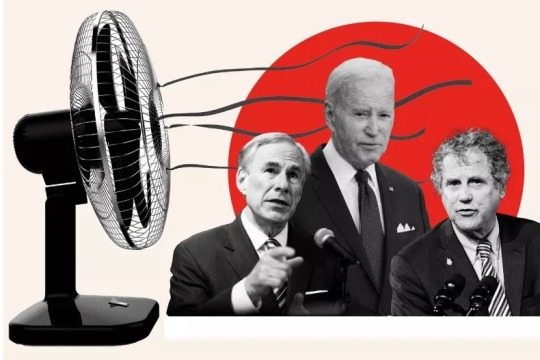
A Newsweek photo graphic showing, from left, Texas Gov. Greg Abbott, Joe Biden and U.S. Senator Sherrod Brown. Newsweek; Source Photo; Brandon Bell/Getty; Alessandro Rampazzo/AFP Via Getty; Angelo Merendino/Getty Images
American workers are dying, local businesses are reporting a drop in productivity, and the country's economy is losing billions all because of one problem: the heat.
July was the hottest month on record on our planet, according to scientists. This entire summer, so far, has been marked by scorching temperatures for much of the U.S. South, with the thermometer reaching triple digits in several places in Texas between June and July.
In that same period, at least two people died in the state while working under the stifling heat enveloping Texas, a 35-year-old utility lineman, and a 66-year-old USPS carrier. According to the Bureau of Labor Statistics, there were 36 work-related deaths due to environmental heat exposure in 2021, the latest data available. This was a drop from 56 deaths in 2020, and the lowest number since 2017.
"Workers who are exposed to extreme heat or work in hot environments may be at risk of heat stress," Kathleen Conley, a spokesperson for the Centers for Disease Control and Prevention (CDC), told Newsweek. "Heat stress can result in heat stroke, heat exhaustion, heat cramps, or heat rashes. Heat can also increase the risk of injuries in workers as it may result in sweaty palms, fogged-up safety glasses, and dizziness. Burns may also occur as a result of accidental contact with hot surfaces or steam."
While there is a minimum working temperature in the U.S., there's no maximum working temperature set by law at a federal level. The CDC makes recommendations for employers to avoid heat stress in the workplace, but these are not legally binding requirements.
The Biden administration has tasked the Occupational Safety and Health Administration (OSHA) with updating its worker safety policies in light of the extreme heat. But the federal standards could take years to develop—leaving the issue in the hands of individual states.
Things aren't moving nearly as fast as the emergency would require—and it's the politics around the way we look at work, the labor market, and the rights of workers in the U.S. that is slowing things down.
A Deep Political Divide
"There's remarkably little in terms of regulation, and of course, given our divided political views in this country—on the right, Republicans in general, are trying to resist more regulation that's premised on continuing global warming," Gregory DeFreitas, Professor of Economics and Director of the Center for the Study of Labor and Democracy at Hofstra University, New York, told Newsweek.
There's a bill, initially introduced in 2019 and now revived by Senator Sherrod Brown of Ohio, a Democrat, that would move in the direction of setting a federal standard for temperature levels, and other heat-related requirements.
The Heat Illness and Fatality Prevention Act would create a universal heat standard requirement through OSHA for workers threatened by hot working conditions.
"No worker should have to endure life-threatening heat to provide for their family. This would be an important step to protect Ohio workers on the job," said Brown in a statement available on his website. "We know too many workers still work in dangerous conditions, putting their health and safety on the line every day to provide for their families. There's not much dignity in a job where you fear for your health or your life."
Newsweek has contacted Brown for comment by phone but did not receive a response.
"Given the political divisions, it's hard to say what its chances of passage are, although you'd think that another record-setting year in heat would put more pressure on taking similar action," DeFreitas said.

Members of the Hays County Emergency Service Districts and the Kyle and Buda Fire Departments rest together while combatting a wildfire during an excessive heat warning on August 08, 2023 in Hays County, Texas. Brandon Bell/Getty Images
This political division over safety regulations in the workplace, according to DeFreitas, started during Donald Trump's presidency. "The minute Trump got in office, he declared war on regulations," he said. "In 2017, he cut OSHA's job safety rules, employers were not required to make as frequent accident reports, there were to be no surprise inspections of factories and workplaces," he said.
"As a result what you have is a weakened federal agency, but that fits with the idea of deregulating businesses and giving them more freedom—the so-called voluntary self-regulation, which was common under both the Bush and the Trump administration."
He added: "That's a deep philosophical orientation of the current Republican Party, regardless of what the dangers are, whether it is climate change or anything else, they want to cut as much regulation and regulatory steps as they can." Newsweek contacted OSHA but did not receive a prompt response.
Billions Up in Smoke
As well as harming or losing people, the country is losing money to the heat.
According to a recent study by the Adrienne-Arsht Rockefeller Foundation Resilience Center, housed at the Atlantic Council, the U.S. is already losing approximately $100 billion on average every year from the drop in labor productivity caused by the current level of heat.
That's "approximately the annual budget for the Department of Homeland Security ($51.7 billion) and the Department of Housing and Urban Development ($44.1 billion) combined (U.S. Government Publishing Office 2019)," researchers write.
The study estimates that, if no significant effort is made to reduce emissions or adapt to extreme heat, labor productivity losses could double to nearly $200 billion by 2030 and reach $500 billion by 2050.
For labor experts, there's no doubt that the extreme heat, which is becoming more frequent due to climate change and our collective failure to bring down carbon emissions on a global level, calls for drastic changes in the way Americans work.
"It's a huge but under-appreciated issue that we're dealing with, not just with outdoor workers, but also oil and gas field workers, people working in warehouses, construction workers," Kurt Shickman, director of Extreme Heat Initiatives at the Adrienne Arsht-Rockefeller Foundation Resilience Center, told Newsweek. "It's a huge swath of our economy that's already increasingly affected by the heat today."
When it's really hot outside, people work more slowly and they are more prone to make mistakes and have accidents, said Shickman. "You may have situations where the weather is so dangerous that you just physically can't have people outside, so you lose work hours," he added.
"We're going to need all kinds of dramatic changes in terms of factory design, warehouse design, and workplace design," said DeFreitas. "The bill is going to be very, very high unless we do something dramatic soon."
Shickman thinks that change is going to depend on regulation. "I don't think we can count on this being self-policed by businesses. It hasn't been so far."
A State-Level Battle
In the immediate future, protecting workers from heat stress—when it's so hot that the body can't keep its ideal internal temperature and can suffer heat stroke and exhaustion—is then up to state lawmakers and the businesses themselves.
California, for example, has set a maximum temperature at which outdoor workers can safely do their job, as well as introducing other regulations aimed at protecting employees, like more frequent periods in the shade and water breaks. More action has been taken in this direction in a handful of states including Minnesota, Washington, Oregon, and New York.
But while states like California have succeeded in introducing effective safety regulations, in other states similar attempts have been rebuffed by the opposition of industry groups and lobbyists.
In Texas, Republican Governor Greg Abbott recently approved a law rescinding city and county ordinances requiring mandatory water breaks for construction workers—a move that generated much controversy and backlash from Texas Democrats. Supporters of the bill, on the other hand, said the law will help rein in local and county officials that have exceeded their authority and will give small businesses the consistency they need to invest and grow.

Heat waves cause distortion on the horizon as a pedestrian walks along South Las Vegas Blvd in Las Vegas, Nevada, on July 30, 2023, as temperatures reach more than 100 degrees Fahrenheit. Patrick T. Fallon/AFP Via Getty Images
In Nevada, lawmakers for months have put off giving final approval to heat safety regulations adopted by OSHA, as the state's Department of Business and Industry discusses the concerns of industry groups over the new policies, as reported by The Washington Post.
"With our workers outside during extreme heat, requiring basic water and rest breaks is just common sense—and it will save lives," Nevada Senator Catherine Cortez Masto, a Democrat, told Newsweek. "As we continue to experience record heat waves, we need to hold employers accountable and protect workers across the country."
The Cost of Change
Investing in making the workplace safer for employees might cost companies more than they're willing to spend, even as they are losing workers' productivity and hours.
"A lot of the generalized skilled work, what we would call lower skilled work, is in warehouses," Lindsey Cameron, an assistant professor of management at the Wharton School, University of Pennsylvania, told Newsweek. "Warehouses are big, massive football fields. It costs a lot of money and a lot of infrastructure to try to cool down. And sometimes it's just impossible because you have all these trucks going in and out and people going in and out."
Some businesses have already moved to protect their workers from heat, knowing that the cost of ignoring the issue could eventually be higher than trying to fix it.

A construction worker moves materials as people sit and drink water along the steps of the Lincoln Memorial in Washington, DC, on July 27, 2023, as temperatures are expected to reach record highs. Brenden Smialowski/AFP Via Getty Images
Jose Garza, the national environmental health and safety leader at California-headquartered general contractor DPR Construction, told Newsweek that the company—which has over 10,000 employees—has implemented heat safety procedures that go beyond the state-mandated regulation, including introducing cooling stations, handing out electrolyte drinks, and giving more breaks to workers.
"We see it as the cost of taking care of people and the right thing to do," he said. "You can either plan for it or react to it, because if you're not planning for it, those breaks are going to happen when the worker is no longer able to work, when they're sick, when they're well beyond the point where their bodies are unable to cool themselves down."
Garza said that employers who care about their workers should go "above and beyond" available regulation to protect them from heat.
'A Long Time' Coming
Experts agree that change won't come from the businesses—and will likely not come soon unless there's committed political action.
"It's really going to take both state and federal movement on this," DeFreitas said. "And I'm hoping that certainly in states like New York, where there does seem to be more attention to workplace safety, that they can move in the direction of the federal bill that's now stuck in progress."
"I don't think the United States has such a great backbone when it comes to climate issues," said Cameron. "We pulled out of the Paris Agreement [under former President Trump in 2017, but rejoined in 2021 under President Joe Biden]. I think there's going to be a lot more attention given to climate change, but it may take a long time to be able to see those changes."
#Newsweek#Too Hot Climate#America’s 🇺🇸 Next Big Labor Battle#Giulia Carbonaro#Scortching Heat#U.S. South#Texas#Bureau of Labor Statistics#Kathleen Conley#Centers For Disease Control and Prevention (CDC)#Occupational Safety and Health Administration (OSHA)#Political Divisions#Republicans#Gregory DeFreitas#Study of Labor and Democracy at Hofstra University | New York#Senator Sherrod Brown of Ohio (D)#The Heat Illness and Fatality Prevention Act#Adrienne-Arsht Rockefeller Foundation Resilience Center#Department of Homeland Security#Department of Housing and Urban Development#Kurt Shickman#Minnesota | Washington | Oregon | New York#Texas Governor Greg Abbott (R)#Nevada#The Washington Post#Nevada Senator Catherine Cortez Masto (D)
0 notes
Text
ISDH: List of locations for new COVID-19 boosters available
New Post has been published on https://aroundfortwayne.com/news/2022/09/13/isdh-list-of-locations-for-new-covid-19-boosters-available/
ISDH: List of locations for new COVID-19 boosters available
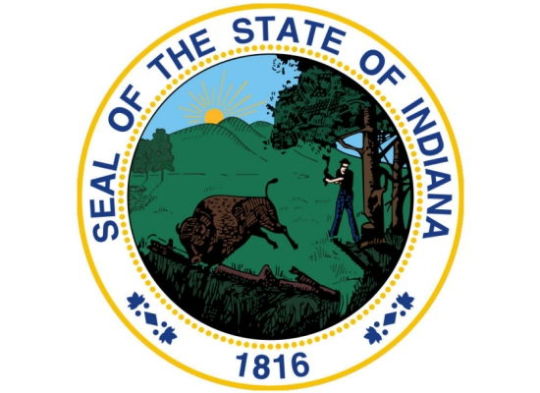
Today, the Indiana State Department of Health announced that it has added locations that are offering the new bivalent COVID-19 booster vaccines to its map.
#CDC Centers for Disease Control and Prevention#COVID-19 pandemic#COVID-19 vaccine#COVID-19 vaccine boosters#COVID-19 variant: Delta B.1.617.2#COVID-19 variant: Omicron B.1.1.529#FDA U.S. Food and Drug Administration#Indiana Health Commissioner Dr. Kris Box#Indianapolis Indiana#ISDH Indiana State Department of Health#Moderna COVID-19 bivalent booster#Moderna COVID-19 Vaccine#Pfizer COVID-19 bivalent booster#Pfizer-BioNTech COVID-19 vaccine
0 notes
Link
#maine#national oceanic and atmospheric administration#centers disease control prevention#u.s. department agriculture#bird flu causing high number of seal deaths
0 notes
Text
youtube
Watch the American Climate Leadership Awards 2024 now: https://youtu.be/bWiW4Rp8vF0?feature=shared
The American Climate Leadership Awards 2024 broadcast recording is now available on ecoAmerica's YouTube channel for viewers to be inspired by active climate leaders. Watch to find out which finalist received the $50,000 grand prize! Hosted by Vanessa Hauc and featuring Bill McKibben and Katharine Hayhoe!
#ACLA24#ACLA24Leaders#youtube#youtube video#climate leaders#climate solutions#climate action#climate and environment#climate#climate change#climate and health#climate blog#climate justice#climate news#weather and climate#environmental news#environment#environmental awareness#environment and health#environmental#environmental issues#environmental justice#environment protection#environmental health#Youtube
15K notes
·
View notes
Text
American workers are dying, local businesses are reporting a drop in productivity, and the country's economy is losing billions all because of one problem: the heat.
July was the hottest month on record on our planet, according to scientists. This entire summer, so far, has been marked by scorching temperatures for much of the U.S. South, with the thermometer reaching triple digits in several places in Texas between June and July.
In that same period, at least two people died in the state while working under the stifling heat enveloping Texas, a 35-year-old utility lineman, and a 66-year-old USPS carrier. According to the Bureau of Labor Statistics, there were 36 work-related deaths due to environmental heat exposure in 2021, the latest data available. This was a drop from 56 deaths in 2020, and the lowest number since 2017.
"Workers who are exposed to extreme heat or work in hot environments may be at risk of heat stress," Kathleen Conley, a spokesperson for the Centers for Disease Control and Prevention (CDC), told Newsweek. "Heat stress can result in heat stroke, heat exhaustion, heat cramps, or heat rashes. Heat can also increase the risk of injuries in workers as it may result in sweaty palms, fogged-up safety glasses, and dizziness. Burns may also occur as a result of accidental contact with hot surfaces or steam."
While there is a minimum working temperature in the U.S., there's no maximum working temperature set by law at a federal level. The CDC makes recommendations for employers to avoid heat stress in the workplace, but these are not legally binding requirements.
The Biden administration has tasked the Occupational Safety and Health Administration (OSHA) with updating its worker safety policies in light of the extreme heat. But the federal standards could take years to develop—leaving the issue in the hands of individual states.
Things aren't moving nearly as fast as the emergency would require—and it's the politics around the way we look at work, the labor market, and the rights of workers in the U.S. that is slowing things down.
952 notes
·
View notes
Text
Though the Centers for Disease Control and Prevention has stopped counting Covid-19 cases, according to wastewater data—which emerged early on as an accurate tracker of the ebbs and flows of the virus—we are currently in one of the biggest surges of the pandemic, amid the spread of a new variant, JN-1, as the virus keeps mutating. More than three-quarters of U.S. hospital beds are currently in use due to Covid hospitalizations. Uptake of the most recent booster shot, which should help to protect against the new variant and lower the risk of severe cases and the odds of getting long Covid, hovers around 19 percent.
Meanwhile, the most recent White House response to a question about whether they had any guidance for hospitals, some of which have brought back mitigation protocols in response to the most recent Covid spike, came courtesy of press secretary Karine Jean-Pierre: “Hospitals, communities, states, they have to make their own decisions. That’s not something we get involved in,” she replied, appearing exasperated.
“We are in possibly the second-biggest surge of the pandemic if you look at wastewater levels,” said Dr. Monica Verduzco-Gutierrez, who runs a long-Covid clinic at the University of Texas, San Antonio, and has had ongoing Covid symptoms since August 2022. “There is no urgency to this. No news. No discussion in Congress. There is no education.”
[...]
Since the Biden administration declared the end of the national emergency in May, Americans across the political spectrum have largely followed the example set by the government and entirely disposed of any level of Covid precautions. Liberal and left-wing outlets have participated in the normalizing of Covid too, dismissing or even ostracizing people who still take precautions as if they are tin-hat conspiracy theorists. “We can’t be in lockdown forever,” has become a common refrain, as if wearing a mask on the subway constitutes “lockdown.”
In September, Biden himself participated in the spread of this kind of harmful disinformation when he declared the pandemic “over” on 60 Minutes. “If you notice, no one’s wearing masks,” he said. “Everybody seems to be in pretty good shape.” This is, essentially, governing via “vibes”—so much for “following the science.”
[...]
The consequences of discarding all Covid precautions are becoming clearer, as more people get repeated infections and long-term symptoms, amid an alarming spike in heart problems among healthy young people. People are getting sick more often not due to the myth of “immunity debt,” which posits that the lack of exposure to other people during lockdown has made people less able to fight off infections (three years later), but because Covid weakens the immune system. Each time someone contracts Covid, the odds of long-term complications increase.
521 notes
·
View notes
Text
Published May 10, 2024
Two new COVID-19 subvariants, collectively nicknamed FLiRT, are increasingly edging out the winter’s dominant strain ahead of a possible summer uptick in coronavirus infections.
The new FLiRT subvariants, officially known as KP.2 and KP.1.1, are believed to be roughly 20% more transmissible than their parent, JN.1, the winter’s dominant subvariant, said Dr. Peter Chin-Hong, an infectious diseases expert at UC San Francisco.
The two FLiRT subvariants combined comprised an estimated 35% of coronavirus infections nationally for the two-week period that began April 28, according to the U.S. Centers for Disease Control and Prevention. By contrast, JN.1 is now believed to comprise 16% of infections; in mid-winter, it was blamed for more than 80%.
#mask up#covid#covid 19#covid isn't over#pandemic#covid conscious#covid is airborne#wear a mask#coronavirus#FLiRT
137 notes
·
View notes
Text
Evil CDC Director Brags Millions of Children Died Suddenly From COVID Jabs.
A bombshell report from the U.S. Centers for Disease Control and Prevention (CDC) has revealed that a staggering 120,000 American children “died suddenly” following the rollout of the mRNA Covid jabs.
The disturbing news has been greeted with radio silence by the mainstream media, who apparently do not consider the deaths of more than one hundred thousand American children to be of any consequence at all.
Meanwhile, the establishment media is consumed with get-Trump reporting and distracting the public with propaganda on the war in Ukraine and the so-called climate crisis.
If the mainstream media is not going to do it’s job, then we will have to do it for them, and red-pill the masses in the process. 🤔
#pay attention#educate yourselves#educate yourself#knowledge is power#reeducate yourself#reeducate yourselves#think for yourselves#think about it#think for yourself#do your homework#do some research#do your own research#ask yourself questions#question everything#lies exposed#world news#news#national news
345 notes
·
View notes
Quote
In Los Angeles County, about 23% of people participating in a weekly text-message-based survey reported having a cough or shortness of breath for the week that ended Dec. 10, higher than the total reported during a late summer peak in respiratory illnesses, when 21% said they had those symptoms. Early summer brought a lull, with only 10% of survey respondents saying they had a cough or shortness of breath.
Meanwhile, coronavirus levels in wastewater in L.A. County are at their highest since summer. Statewide, the level of flu-like illness — which includes non-flu viruses such as the coronavirus — is considered high, according to the U.S. Centers for Disease Control and Prevention.
Everyone seems to be sick in California. Here's why - Los Angeles Times
359 notes
·
View notes
Text
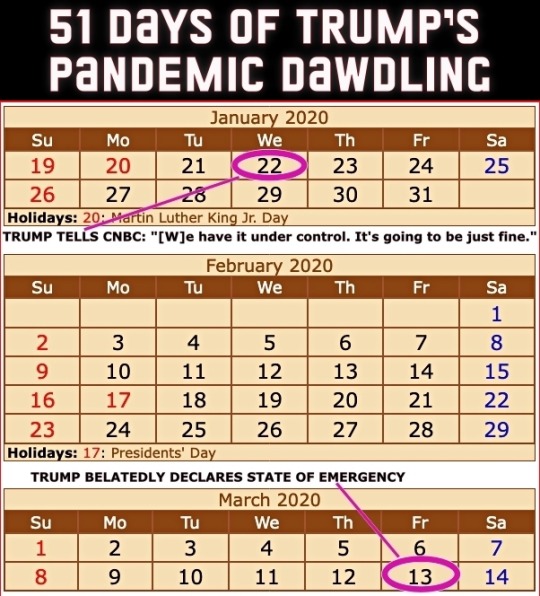
Four years ago today (March 13th), then President Donald Trump got around to declaring a national state of emergency for the COVID-19 pandemic. The administration had been downplaying the danger to the United States for 51 days since the first US infection was confirmed on January 22nd.
From an ABC News article dated 25 February 2020...
CDC warns Americans of 'significant disruption' from coronavirus
Until now, health officials said they'd hoped to prevent community spread in the United States. But following community transmissions in Italy, Iran and South Korea, health officials believe the virus may not be able to be contained at the border and that Americans should prepare for a "significant disruption."
This comes in contrast to statements from the Trump administration. Acting Department of Homeland Security Secretary Chad Wolf said Tuesday the threat to the United States from coronavirus "remains low," despite the White House seeking $1.25 billion in emergency funding to combat the virus. Larry Kudlow, director of the National Economic Council, told CNBC’s Kelly Evans on “The Exchange” Tuesday evening, "We have contained the virus very well here in the U.S."
[ ... ]
House Speaker Nancy Pelosi called the request "long overdue and completely inadequate to the scale of this emergency." She also accused President Trump of leaving "critical positions in charge of managing pandemics at the National Security Council and the Department of Homeland Security vacant."
"The president's most recent budget called for slashing funding for the Centers for Disease Control, which is on the front lines of this emergency. And now, he is compounding our vulnerabilities by seeking to ransack funds still needed to keep Ebola in check," Pelosi said in a statement Tuesday morning. "Our state and local governments need serious funding to be ready to respond effectively to any outbreak in the United States. The president should not be raiding money that Congress has appropriated for other life-or-death public health priorities."
She added that lawmakers in the House of Representatives "will swiftly advance a strong, strategic funding package that fully addresses the scale and seriousness of this public health crisis."
Senate Minority Leader Chuck Schumer also called the Trump administration's request "too little too late."
"That President Trump is trying to steal funds dedicated to fight Ebola -- which is still considered an epidemic in the Democratic Republic of the Congo -- is indicative of his towering incompetence and further proof that he and his administration aren't taking the coronavirus crisis as seriously as they need to be," Schumer said in a statement.
A reminder that Trump had been leaving many positions vacant – part of a Republican strategy to undermine the federal government.
Here's a picture from that ABC piece from a nearly empty restaurant in San Francisco's Chinatown. The screen displays a Trump tweet still downplaying COVID-19 with him seeming more concerned about the effect of the Dow Jones on his re-election bid.

People were not buying Trump's claims but they were buying PPE.
I took this picture at CVS on February 26th that year.
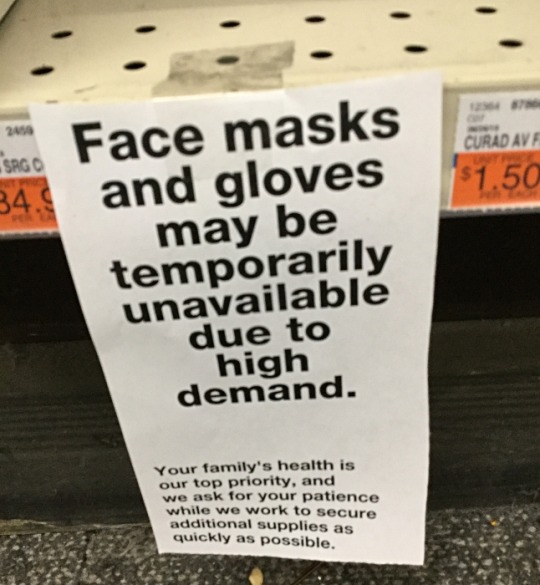
The stock market which Trump in his February tweet claimed looked "very good" was tanking on March 12th – the day before his state of emergency declaration.

Trump succeeded in sending the US economy into recession much faster than George W. Bush did at the end of his term – quite a feat!. (As an aside, every recession in the US since 1981 has been triggered by Republican presidents.)
Of course Trump never stopped trying to downplay the pandemic nor did he ever take responsibility for it. The US ended up with the highest per capita death rate of any technologically advanced country.
Precious time was lost while Trump dawdled. Orange on this map indicates COVID infections while red indicates COVID deaths. At the time Trump declared a state of emergency, the virus had already spread to 49 states.

The United States could have done far better and it had the tools to do so.
The Obama administration had limited the number of US cases of Ebola to under one dozen during that pandemic in the 2010s. Based on their success, they compiled a guide on how the federal government could limit future pandemics.
Obama team left pandemic playbook for Trump administration, officials confirm
Of course Trump ignored it.
Unlike those boxes of nuclear secrets in Trump's bathroom, the Obama pandemic limitation document is not classified. Anybody can read it – even if Trump didn't. This copy comes from the Stanford University Libraries.
TOWARDS EPIDEMIC PREDICTION: FEDERAL EFFORTS AND OPPORTUNITIES IN OUTBREAK MODELING
Feel free to share this post with anybody who still feels nostalgic about the Trump White House years!
#covid-19#coronavirus#pandemic#public health#donald trump#trump's incompetent response to the pandemic#covid state of emergency#2020#trump recession#51 days of trump pandemic dawdling#obama pandemic playbook#2010s ebola outbreak#nostalgia for trump administration#republicans#election 2024#vote blue no matter who
109 notes
·
View notes
Text
"Sanofi on Thursday said it’s planning to cut the U.S. price of its most popular insulin drug by 78% and cap monthly out-of-pocket costs at $35 for people who have private insurance starting next year.
In addition to its widely prescribed Lantus, the French drugmaker will reduce the list price of its short-acting insulin Apidra by 70%. Sanofi already offers a $35 monthly cap on insulin for uninsured diabetes patients.
The company is the last major insulin manufacturer to try to head off government efforts to cap monthly costs by announcing its own steep price cuts for the lifesaving hormone.
Eli Lilly and Novo Nordisk made similar sweeping cuts earlier this month after years of political pressure and public outrage over the high costs of diabetes care. The three companies control over 90% of the global insulin market.
... The change takes effect Jan. 1.
President Joe Biden’s Inflation Reduction Act capped monthly insulin costs for Medicare beneficiaries at $35, but it did not provide protection to diabetes patients who are covered by private insurance.
Sen. Bernie Sanders, a Vermont independent and the chairman of the Senate Health, Education, Labor and Pensions Committee, introduced a bill earlier this month that would cap the list price of insulin at $20 per vial.
Both the president and Sanders on Tuesday directly called on Sanofi to slash its prices after Novo Nordisk announced its own cuts that day.
Roughly 37 million people in the U.S., or 11.3% of the country’s population, have diabetes, according to the Centers for Disease Control and Prevention. Approximately 8.4 million [U.S.] diabetes patients rely on insulin, the American Diabetes Association said."
-via CNBC, 3/16/23
#insulin#big pharma#diabetes#health care#eli lilly and co#us healthcare#healthcare access#prescription drugs#biden#bernie sanders#health insurance#united states#us politics#good news#hope#it should start IMMEDIATELY and I hope their efforts to avoid gov price caps FAIL WITH EXTREME PREJUDICE#but the important thing is access to affordable insulin#so i'll take the progress#affordable healthcare
517 notes
·
View notes
Text
COVID-19 vaccines available for children under 5
New Post has been published on https://aroundfortwayne.com/news/2022/06/21/covid-19-vaccines-available-for-children-under-5/
COVID-19 vaccines available for children under 5
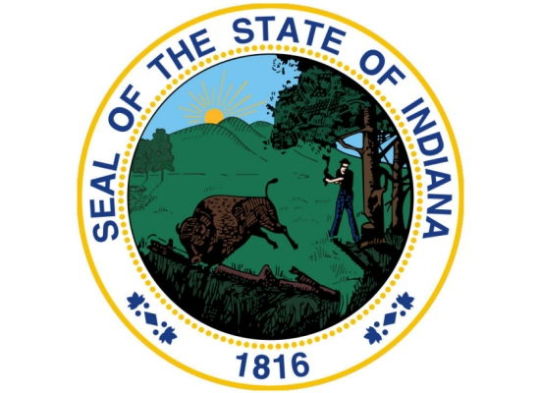
Today, the ISDH announced that COVID-19 vaccines for children ages 6 months up to age 5 are now available at some Indiana providers, expanding the population eligible to be protected against the disease.
#CDC Centers for Disease Control and Prevention#COVID-19 pandemic#COVID-19 vaccine#FDA Emergency Use Authorization#FDA U.S. Food and Drug Administration#Indianapolis Indiana#ISDH Indiana State Department of Health#Moderna COVID-19 Vaccine#Pfizer-BioNTech COVID-19 vaccine
0 notes
Text


Krystal Anderson, a former cheerleader for the Kansas City Chiefs, died of sepsis last week following a stillbirth, according to her family. She was 40 years old.
Anderson, known to her friends as “Krissy,” was hospitalized at five months pregnant and delivered her daughter, Charlotte Willow, after doctors were unable to locate a heartbeat, friends told FOX4 News. She developed a fever a day after the birth. Her condition worsened and she battled sepsis, which eventually led to organ failure. Despite being placed on life support and undergoing three surgeries, she died early Wednesday morning.
“I feel lost,” her husband, Clayton Anderson, told the station. “There’s a lot of people in this house and it feels empty.”
In her post-NFL career, Anderson taught yoga and worked as a software engineer at Oracle Health. She “fiercely advocated” for both Black women in STEM and women’s health, according to an obituary. She also had a philanthropic streak, and worked with Big Brothers and Big Sisters of KC, the perinatal bereavement nonprofit Gabriella’s Little Library, and the Oracle Health Foundation.
“She was an absolute force for good. She made every room just light up,” her husband said.
While overall maternal deaths in the U.S. have steadily ticked up over the past two decades, Black women remain two to three times more likely to die in childbirth than white women, according to data from the Centers for Disease Control and Prevention. With the risks to Black mothers exacerbated by implicit bias and medical racism, they are also more likely to experience life-threatening complications like preeclampsia, postpartum hemorrhage, and blood clots.
“It’s, you know, we say, the best country in the world, right?” Anderson’s husband told FOX4 News. “Not if you’re a Black pregnant woman, it’s not—and that needs to change.”
(continue reading)
60 notes
·
View notes
Note
I heard we are now at the cusp of chlamydia being untreatable via antibiotics, fun times
In United States, drug-resistant gonorrhea is a public health problem of national concern. But untreatable gonorrhea isn’t the only STD that has health officials worried.
Earlier this week, the World Health Organization released new treatment guidelines for three common sexually transmitted diseases — chlamydia, gonorrhea, and syphilis— in response to increasing antibiotic resistance.
Gonorrhea has developed the strongest resistance to drugs, but the worries about untreatable syphilis and chlamydia come at a time when rates for the three STDs are rising rapidly in the U.S, especially among young people ages 20 to 24. According to data published by the CDC in 2014, the most recent year available: cases of chlamydia have increased 2.5 percent; gonorrhea 5.1 percent; and syphilis 15.1 percent. This is the first increase in the United States since 2006.
How worried should we be?
“STDs are hidden epidemics of enormous health and economic consequence in the United States,” according to the Centers for Disease Control and Prevention.
In the US, STDs are most frequent among college-age women, the highest prevalence being among women, ages 20 to 24.
According to the CDC, there are about 820,000 new gonorrhea infections each year in the United States. In fact, gonorrhea is the second most commonly reported infectious disease, after chlamydia.
In the past, gonorrhea was successful treated by several classes of antibiotics, including the ubiquitous penicillin. Over time, however, gonorrhea has developed resistance to many of them, and now, we are down to one recommended effective class of antibiotics to treat it.
The problem doesn’t end there. Gonorrhea is even starting to show decreased susceptibility to this “last line” treatment option. This makes this bacterium a multidrug-resistant organism, which are often called “superbugs”.
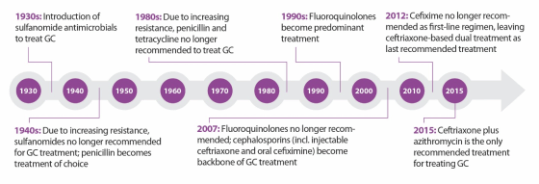
As for chlamydia and syphilis, drug resistant strains have not become common in the US yet, but the WHO report warns that this is a growing problem in many parts of the world.
How can untreatable STDs be prevented?
Anyone who is sexually active can get an STD.
That said, STDs are preventable and there are steps you can take to keep yourself and your partner healthy. Remember that protecting your health is your responsibility:
Condoms: Use them correctly every time you have sex.
Have fewer partners: Ideally, agree to only have sex with one person who agrees to only have sex with you.
Talk with your partner: Talk with your sex partner about STDs and staying safe before having sex.
Get tested: Make sure you both get tested to know for sure that neither of you has an STD.
Get vaccinated: Safe and highly effective vaccines are available for two STDs: hepatitis B and HPV. HPV is in fact the most common STD. There are specific recommendations for routine and catch up vaccinations for these two STDs.
____________________
This is from 2016 and I cut a bunch out of the middle.
2nd bullet point there probably gonna make some people grumpy, something about suggesting monogamy makes people mad.
102 notes
·
View notes